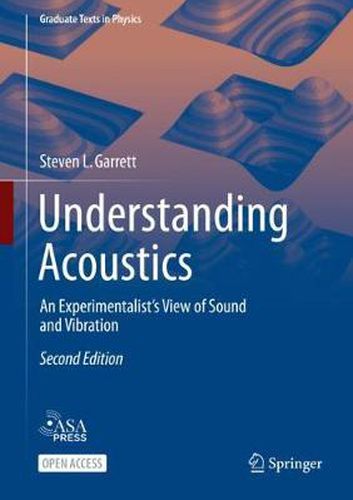Readings Newsletter
Become a Readings Member to make your shopping experience even easier.
Sign in or sign up for free!
You’re not far away from qualifying for FREE standard shipping within Australia
You’ve qualified for FREE standard shipping within Australia
The cart is loading…






This title is printed to order. This book may have been self-published. If so, we cannot guarantee the quality of the content. In the main most books will have gone through the editing process however some may not. We therefore suggest that you be aware of this before ordering this book. If in doubt check either the author or publisher’s details as we are unable to accept any returns unless they are faulty. Please contact us if you have any questions.
This open access textbook, like Rayleigh’s classic Theory of Sound, focuses on experiments and on approximation techniques rather than mathematical rigor. The second edition has benefited from comments and corrections provided by many acousticians, in particular those who have used the first edition in undergraduate and graduate courses. For example, phasor notation has been added to clearly distinguish complex variables, and there is a new section on radiation from an unbaffled piston. Drawing on over 40 years of teaching experience at UCLA, the Naval Postgraduate School, and Penn State, the author presents a uniform methodology, based on hydrodynamic fundamentals for analysis of lumped-element systems and wave propagation that can accommodate dissipative mechanisms and geometrically-complex media. Five chapters on vibration and elastic waves highlight modern applications, including viscoelasticity and resonance techniques for measurement of elastic moduli, while introducing analytical techniques and approximation strategies that are revisited in nine subsequent chapters describing all aspects of generation, transmission, scattering, and reception of waves in fluids. Problems integrate multiple concepts, and several include experimental data to provide experience in choosing optimal strategies for extraction of experimental results and their uncertainties. Fundamental physical principles that do not ordinarily appear in other acoustics textbooks, like adiabatic invariance, similitude, the Kramers-Kronig relations, and the equipartition theorem, are shown to provide independent tests of results obtained from numerical solutions, commercial software, and simulations. Thanks to the Veneklasen Research Foundation, this popular textbook is now open access, making the e-book available for free download worldwide.
Provides graduate-level treatment of acoustics and vibration suitable for use in courses, for self-study, and as a reference Highlights fundamental physical principles that can provide independent tests of the validity of numerical solutions, commercial software, and computer simulations Demonstrates approximation techniques that greatly simplify the mathematics without a substantial decrease in accuracy Incorporates a hydrodynamic approach to the acoustics of sound in fluids that provides a uniform methodology for analysis of lumped-element systems and wave propagation Emphasizes actual applications as examples of topics explained in the text Includes realistic end-of-chapter problems, some including experimental data, as well as a Solutions Manual for instructors. Features Talk Like an Acoustician boxes to highlight key terms introduced in the text.
$9.00 standard shipping within Australia
FREE standard shipping within Australia for orders over $100.00
Express & International shipping calculated at checkout
This title is printed to order. This book may have been self-published. If so, we cannot guarantee the quality of the content. In the main most books will have gone through the editing process however some may not. We therefore suggest that you be aware of this before ordering this book. If in doubt check either the author or publisher’s details as we are unable to accept any returns unless they are faulty. Please contact us if you have any questions.
This open access textbook, like Rayleigh’s classic Theory of Sound, focuses on experiments and on approximation techniques rather than mathematical rigor. The second edition has benefited from comments and corrections provided by many acousticians, in particular those who have used the first edition in undergraduate and graduate courses. For example, phasor notation has been added to clearly distinguish complex variables, and there is a new section on radiation from an unbaffled piston. Drawing on over 40 years of teaching experience at UCLA, the Naval Postgraduate School, and Penn State, the author presents a uniform methodology, based on hydrodynamic fundamentals for analysis of lumped-element systems and wave propagation that can accommodate dissipative mechanisms and geometrically-complex media. Five chapters on vibration and elastic waves highlight modern applications, including viscoelasticity and resonance techniques for measurement of elastic moduli, while introducing analytical techniques and approximation strategies that are revisited in nine subsequent chapters describing all aspects of generation, transmission, scattering, and reception of waves in fluids. Problems integrate multiple concepts, and several include experimental data to provide experience in choosing optimal strategies for extraction of experimental results and their uncertainties. Fundamental physical principles that do not ordinarily appear in other acoustics textbooks, like adiabatic invariance, similitude, the Kramers-Kronig relations, and the equipartition theorem, are shown to provide independent tests of results obtained from numerical solutions, commercial software, and simulations. Thanks to the Veneklasen Research Foundation, this popular textbook is now open access, making the e-book available for free download worldwide.
Provides graduate-level treatment of acoustics and vibration suitable for use in courses, for self-study, and as a reference Highlights fundamental physical principles that can provide independent tests of the validity of numerical solutions, commercial software, and computer simulations Demonstrates approximation techniques that greatly simplify the mathematics without a substantial decrease in accuracy Incorporates a hydrodynamic approach to the acoustics of sound in fluids that provides a uniform methodology for analysis of lumped-element systems and wave propagation Emphasizes actual applications as examples of topics explained in the text Includes realistic end-of-chapter problems, some including experimental data, as well as a Solutions Manual for instructors. Features Talk Like an Acoustician boxes to highlight key terms introduced in the text.